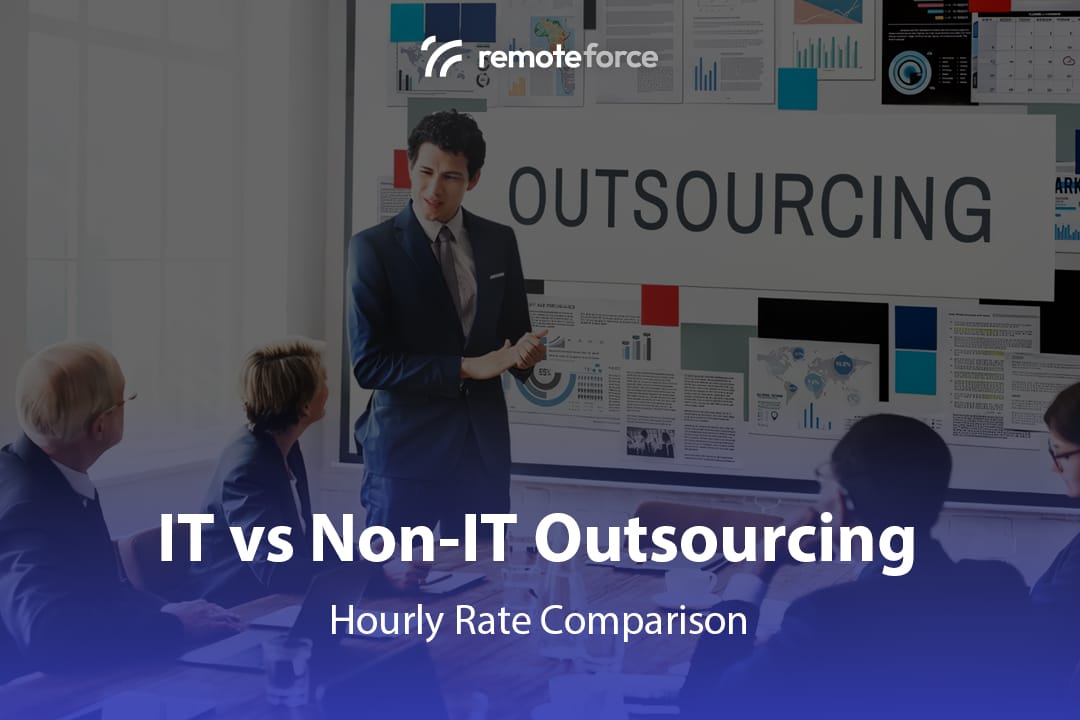The Hourly Rate is one of the most common and flexible pricing models in the outsourcing industry, especially for projects under the Time & Material (T&M) agreement. It offers transparency and direct linkage between the effort expended and the cost incurred.
However, a critical question for businesses is: Why do IT outsourcing rates often differ significantly from Non-IT professional services rates, and what exactly does that hourly fee cover?
Understanding the factors that differentiate these rates is crucial for smart budgeting and choosing the right manpower for your specific needs, whether it’s a dedicated web developer or an expert accountant.
Table of Contents
ToggleUnderstanding the Components of an Hourly Rate
A vendor’s hourly rate is never just the outsourced employee’s salary divided by the number of hours in a month. It is a comprehensive charge designed to cover the Total Cost of Ownership (TCO) for that employee, plus the vendor’s operational and legal overhead.
The rate structure typically includes:
- Direct Labor Cost: The employee’s gross salary, bonuses, and mandatory benefits (health insurance, social security contributions).
- Overhead & Infrastructure: Costs associated with providing the service: office space, utilities, hardware, software licenses (e.g., specialized web development tools or accounting platforms), and security infrastructure.
- Management & Quality Assurance: The cost of the vendor’s internal project managers, team leaders, HR support, and quality assurance (QA) staff.
- Vendor Risk & Compliance: The fee for the vendor to absorb legal risks, ensure labor compliance, and handle employee replacement/attrition.
- Profit Margin: The vendor’s return on investment for running the business.
Hourly Rate Comparison: IT vs Non-IT Services
The difference in hourly rates between IT (Information Technology) and Non-IT services is primarily driven by three factors: the Scarcity of Skill, the Risk Profile, and the Required Tooling.
1. IT Outsourcing Services (High Rate Potential)
IT outsourcing encompasses highly technical roles like web and app development, system administration, cybersecurity, and data science. These services typically command higher hourly rates.
| IT Role Examples | Rate Influencers | Key Drivers for Higher Cost |
|---|---|---|
| Full-Stack Developer, DevOps Engineer, Cybersecurity Expert | Scarcity & Demand: High global demand for niche, constantly evolving technical skills. | Specialized Tooling: Expensive licenses for IDEs, cloud services (AWS, Azure), testing frameworks, and high-spec hardware. |
| Project Complexity: IT failures can lead to massive financial losses (e.g., data breaches, system downtime). The vendor assumes higher risk. | ||
| Certification: High-value certifications (e.g., AWS Certified Architect, CISSP) command premium rates. |
2. Non-IT Professional Services (Variable and Competitive Rates)
Non-IT professional services include functions like Digital Marketing, Graphic Design, Secretarial, Legal Counsel, and Accounting. While highly specialized, their rates can be more competitive and vary based on the specific function.
| Non-IT Role Examples | Rate Influencers | Key Drivers for Variation |
|---|---|---|
| Digital Marketing Specialist, CPA/Accountant, Paralegal | Compliance Risk: Roles like legal and accounting carry high regulatory and audit risk, driving rates up to ensure expertise. | Tooling Costs: Costs are often moderate (e.g., QuickBooks, Adobe Creative Suite, SEO tools). |
| Standardization: Tasks in secretarial or basic accounting are often more standardized and repeatable, leading to more competitive pricing. | ||
| Soft Skills: Rates reflect communication skills, industry experience, and strategic input. |
Key Factors That Drive Hourly Rate Fluctuations
Whether IT or Non-IT, several common factors will always influence the final rate you are quoted:
1. Geographic Location (The Labor Arbitrage)
The most significant factor remains the vendor’s location. An expert based in a region with a lower cost of living and lower wage ceiling (e.g., many countries in Southeast Asia) will have a significantly lower hourly rate than an equivalent expert in Western Europe or North America. This is the core benefit of manpower outsourcing.
2. Level of Expertise and Seniority
- Senior (Expert): Higher rates due to deep experience, problem-solving skills, and requiring minimal supervision. Essential for high-risk legal or strategic digital marketing planning.
- Junior (Entry-Level): Lower rates, but may require more time and supervision from your in-house team, potentially increasing the overall project time.
3. Contract Length and Volume
- Long-Term Contract: Vendors typically offer better hourly rates for long-term engagements (e.g., 12 months or more) under the Dedicated Team Model, as it provides them with revenue stability.
- High Volume: Outsourcing a large team (e.g., 10 accountants) usually yields a bulk discount compared to hiring a single resource.
4. Specialization and Certification
A Certified Public Accountant (CPA) or a PMP-certified project manager will command a higher rate than an uncertified counterpart, but their value in ensuring compliance and project success far outweighs the added cost.
Strategic Advice: Calculating True Value Over Rate
When evaluating vendor proposals, focus on value rather than just the lowest rate.
| Trap to Avoid | Strategic Focus |
|---|---|
| The Low-Rate Trap | A $15/hour rate is cheap, but if the resource takes 100 hours to complete a task that a skilled resource completes in 30 hours, you pay more in the end. |
| Focus on TCO | Look for the vendor who bundles most costs (e.g., management, infrastructure, HR) into the hourly rate for predictability. |
| Ignoring Risk | Cheaper vendors often cut corners on legal compliance or data security. The potential cost of a lawsuit or data breach far exceeds any hourly savings. |
| Prioritize Compliance | Ensure the vendor guarantees full compliance and absorption of legal risks, especially for high-stakes roles like legal and accounting. |
Conclusion
Whether you are seeking a high-value IT specialist or a compliant non-IT professional, the hourly rate in outsourcing is a clear reflection of expertise, risk, and the supporting infrastructure provided by the vendor. The critical factor is confirming that the rate is tied to a certified, competent, and fully compliant individual.
At RemoteForce, we offer transparent, competitive hourly rates for certified manpower across all sectors, including high-demand roles like web and app development, digital marketing, legal, and secretarial support. We eliminate the risk and complexity of TCO by ensuring our rates cover all legal compliance and operational overhead, giving you access to premium talent without the premium local price tag. Ready to connect with qualified experts whose hourly rate reflects true value?




